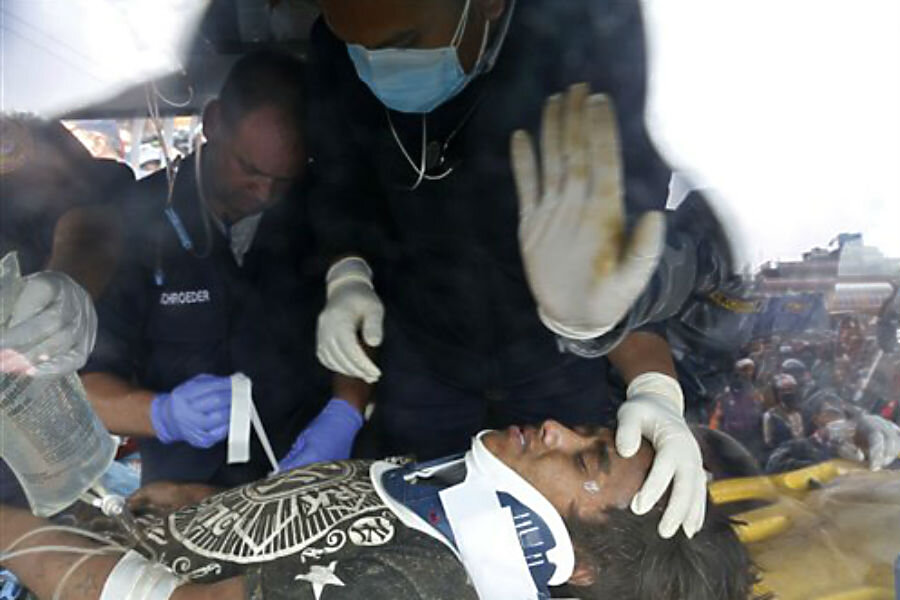Nepal quake: Two new rescues boost spirits amid sluggish aid delivery
UPDATE: Police said late Thursday that a woman in her 20s has been rescued six days after Nepal's massive earthquake. A police official identified the woman as Krishna Devi Khadka and said she was rescued Thursday evening in an area near Kathmandu's main bus terminal, reported the Associated Press.
Another stunning sign of life emerged from the rubble in Nepal's capital as a teenager trapped for 80 hours under the Hilton Hotel was pulled out, six days after a 7.8 magnitude earthquake.
Rescuers also saved a dusty four-month old baby in Bhaktapur and a farmer from west Nepal who was rescued in Kathmandu after three days. The farmer had been en route to a job at a Kentucky Fried Chicken in Dubai.
Yet stories of those liberated from collapsed buildings offer only a brief respite from the clamor for food, clean water, and tents, according to relief agencies who say locals are growing angry amid a slow and disjointed response, exacerbated by persistent rainfall.
“The United Nations has said up to eight million people have had their lives disrupted by the earthquake and said there was an urgent need for relief materials ranging from tarpaulin sheets and clean water to soap and medicines,” according to Reuters.
Thursday's rescue of 18-year old Pemba Tamang came after a Nepali rescue team removed a crushed motorcycle from a flattened steel section of the hotel that allowed the team to reach the trapped teen. As Mr. Tamang was lifted out, he said, “I’m cold."
The largest quake in Nepal in eight decades turned neighborhoods into rubble, destroyed numerous ancient monuments, and has resulted in a death toll so far of nearly 5,500. But stories of recovery are also emerging, including social media posts seen around the world.
Four month old baby Sonit Awal was found amid dense rubble after a recovery team in Bhaktapur outside Kathmandu was preparing to move out. The baby’s parents implored the team to try a final time and as another layer of debris was removed, a faint cry was heard.
The rescued farmer, Risi Ram Khanal, had only arrived in Kathmandu three days before the quake. According to Reuters, he was to fly last Monday to Dubai after borrowing some $1,000 and leaving his wife and child behind. His job in Dubai would have paid $220 a week. Studies show that remittances from overseas workers provide up to a quarter of Nepal’s GDP.
A morale boost from the sharing of such stories along with the practical effect that can result from aid and information via social media is providing a new dimension to disaster responses, the Monitor editorialized this week:
Disaster experts have long focused on helping communities in a crisis to concentrate on their collective competency and shared intelligence rather than remaining stuck in feelings of dependency. Social media helps breaks down a sense of separation. It amplifies each individual’s potential contribution.
Along with an ongoing need for basic necessities of clean water, food, and tents, officials and rescuers say they are still probing on the ground and by helicopter the hard-to-reach rural areas hit by the quake and deadly aftershocks.
These include the districts of Gorkha and Sindhupalchowk, north of the capital. Sindhupalchowk has some 500 communities seriously damaged or flattened, the Monitor reported earlier this week.
“The scale of destruction in the district is indescribable," [Chief District Administrator] Mr. Gyawali says. "We need tents, clean water, and food to save those who survived."
A helicopter dropped relief goods at the Sindhupalchowk district headquarters Tuesday. But Gyawali says it isn’t possible for security personnel and government officials to take these supplies to the affected villages.
Reuters on Thursday sent a team to a village in Gorkha:
In Ashrang village in Gorkha, one of the worst-hit districts about four hours by road from Kathmandu, hundreds of Nepali villagers were living out in the open with little food and water despite boxes of biscuits, juices and sacks of rice and wheat being stored in a nearby government office. Police commandos shut the high iron gates of the building, refusing people access while they counted the relief supplies. "We told them we can manage without their help," said Mohammad Ishaq, a school teacher, who had been offered four plastic sheets. "It is as if we are doing everything on our own, feeding our people, tending to the sick."






